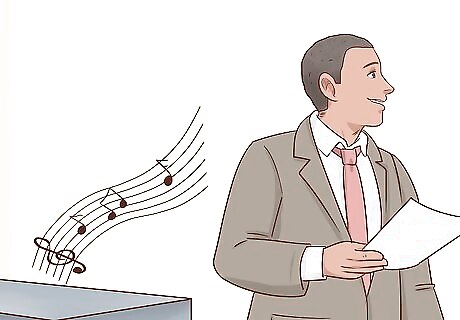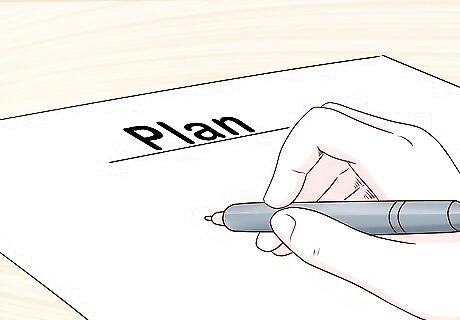
views
Including Relevant Information in Your Introduction

State your name clearly. You want the audience to remember who you are, so don’t mumble or rush through saying your name. Speak loudly and confidently so you fill the space, and make sure you enunciate every syllable. If you have an unusual or difficult to pronounce name, you may want to add a small remark to help your audience remember it. For example, you can say “My name is Jacob Misen, like ‘risen’ but with an M.” Try to make eye contact with parts of audience during your presentation as well.

Communicate your contribution to get the audience excited. Think about how you will help your audience and briefly communicate that rather than just listing your credentials or job title. Your basic credentials will probably be listed on the presentation program, anyway. Ask yourself what special skills and experience you have that would interest your audience and introduce yourself with those. If you are VP of Marketing at a large company, it can actually be much more effective to say something like “I have more than a decade of experience using Facebook marketing ads to target clients in the dance industry” rather than simply stating your job title.

Leave extra details on a handout or powerpoint slide. If there are other details about yourself that are interesting and relevant to the presentation, you don’t have to list them all in your introduction. Instead, add them to your handout or powerpoint presentation. Your audience can read them there if they want. You can also specifically refer your audience to the handout or powerpoint for more information. For example, if you want to let them know that you have articles in many international newspapers but you don’t want to list them all out, simply say “I’ve written for a number of internationally recognized news organizations. You can find the full list on the first page of my handout.”

Save some relevant details about yourself for later in the presentation. You don’t have to give the audience everything about yourself right away. Stick to the most interesting and relevant information. If you have other interesting personal details you want to share, you can add them in other parts of the presentation. For example, you could say “when I designed a website for Richard Branson last year …” to inform your audience that you have an impressive resume, without having to list it all for them in your introduction.

Plan a smooth transition from the introduction to your content. Once you’ve got a great introduction, it’s important you seamlessly and effectively transition into the meat of your presentation. Having a planned transition will also help you maintain your confidence because you’ll know exactly where you are going and how to get there. Try concluding your introduction by mentioning a client or project you were working on that directly relates to the topic of your presentation. For example: “I’ve had the pleasure of working with NXP Semiconductors for the past three years. Just last week we encountered a problem with our logistical database...” and then lead into your presentation about a new software that will solve everyone’s logistical hiccups.
Grabbing Your Audience’s Attention Before Your Introduction

Set the mood with music to get the audience energized. Playing music as you walk up to the presentation area and for a few seconds before you start to speak shares your personality and gets the audience’s attention. This works best if you can reference the lyrics or artist as the music fades and you begin your presentation. If you don’t have music that can tie to your presentation, you can use a song with the theme of beginning. For example, if you are presenting at a sales meeting, play some soft jazz as participants enter. Then, when it’s time for you to start, play the Black Eyed Peas chorus of “Let’s Get it Started” to get your audience’s attention. You can then open with an energetic “Good morning!” or “Good Afternoon” as the music ends. Remember to choose music that’s appropriate to the event. An academic conference may not be the best place for pop music, for example (unless you are presenting research on pop music, of course).

Use an attention-grabbing quotation before you introduce yourself. Share a short, relevant quote before you say your name. This can get your audience interested in the topic. It’s even better if the author of the quote is a big name in the industry you are speaking to. The audience will recognize the name and it will lend credibility to your presentation. For example, if you are presenting on the design of a new user-friendly coffee machine, you may start your presentation by referencing Elon Musk: “Any product that needs a manual to work is broken,” and then go on to say “My name is Laurie Higgens, and my coffee machine doesn’t come with a manual.” Speak briefly about your relevant experience and qualifications, and then dive into presenting your design. Avoid cliche or overused motivational quotes the audience has probably already heard many times. Be sure to correctly cite your quote.

Get the audience thinking by leading with a revealing statistic. Starting by presenting a statistic that illustrates a problem that your presentation will address or attempt to solve can be a great attention-grabbing move. In many cases, the audience might not even realize there is a problem until you point it out to them. Once you do, they will be more alert and invested in hearing solutions from you. For example, you might start with “According to Time magazine, Americans filled 4.3 billion prescriptions and doled out $374 billion on medicine in 2014.” Then, introduce yourself and your qualifications in medical research and transition into a presentation about how to prevent doctors from over prescribing medication to their patients. Remember to cite the source of your statistics. You will look more professional and reliable, and the audience will be able to follow up on the information if they wish.

Connect to the audience and invite them to reflect with a question. Asking a question transforms your audience into participants. Try to pick universal situations that everyone in the audience will have some experience with or opinion about. Make sure it ties directly into your presentation material, too. If you are giving a presentation about a new airport security-friendly travel bag, try starting your presentation with “How many of you have ever stood in line at airport security and nearly missed your flight?” You can also invite your audience to close their eyes and imagine something as you lead up to your question. Don’t be discouraged if your audience doesn’t raise their hands when you ask a question. Sometimes these questions seem more rhetorical to an audience, or maybe they are just shy. You can often see signs that they are still engaging with the question if people are nodding or smiling after you ask it.

Employ humor to relax yourself and the audience. Laughter can create an instant connection between a speaker and the audience. Start your introduction by making fun of yourself or exaggerating your own experiences in a humorous way. Don’t overdo the humor. Make it natural without trying to force a laugh. Be sure that any jokes or ironies you use are appropriate for the context in which you are speaking. Try telling stories, showing pictures on a powerpoint, or using quotations. Being funny not only puts your audience at ease, but it also helps them remember you after the presentation.

Involve the audience if you are presenting to a small group. Giving a presentation can be a very lonely and isolating experience. If you have a small audience, however, you can involve them in your introduction. After you introduce yourself, ask the audience members to introduce themselves and state a question or concern that relates to your presentation topic. You will take a bit of pressure off yourself, keep your audience alert, and get to know them at the same time. For example, if you are making a presentation about a pizza delivery app, ask your audience members to tell their name, their favorite pizza topping, and a situation where they’ve had a particularly amazing or awful experience with food delivery.
Preparing Before Your Presentation

Make a plan and write it down. It’s best to have a plan for how you will introduce yourself so you don’t get lost or confused when you’re on stage. It’s even better if you can write your plan down so you can review it beforehand or refer to it during your presentation. You can write down every sentence if you’d like, especially for practicing the introduction. When it’s time to present, it’s probably best to just write down a few notes or key words to remind you of what you want to say so you don’t just read off your note cards. Think about your overall intention as a speaker. Are you trying to educate, enlighten, or entertain the audience? Figure out the effect you want to have on the listener so your presentation is impactful.

Rehearse your introduction with a friend. Practicing your introduction out loud will help you speak with the right intonation and at the right pace so your message will be clear and interesting. You can also time yourself and add or remove certain parts of your introduction until you’ve got it just right. Ask your friend for constructive feedback and advice on how to improve. Practicing out loud will also help you gain confidence. If you don’t have a friend to watch your presentation, record yourself on video and play it back later to refine your presentation skills. It can be uncomfortable to watch yourself on video, but it will help you nail your introduction. You can even record your whole presentation. Keep recording and re-recording until you are happy with it. Then you know the audience will be happy too.

Research the culture where you will present so you don’t offend anyone. You will want to make a good first impression with your introduction, so be sure you know what is expected of you and what might be frowned upon. Research the local culture where you will be speaking: what do they normally wear in the industry there? Do they introduce themselves by first name only, or with their first and last name? Be mindful of international customs too. In some places, it’s not appropriate to use humor. If you are unsure about your audience, leave the humor out. The best resource to learn about the local culture is the locals themselves. If you have a contact where you will be speaking, ask them about customs, dress code, and how humor is usually received. If you don’t know anyone personally, try searching in industry-specific online forums. Find YouTube videos of presentations given in the area that are relevant to your industry.

















Comments
0 comment